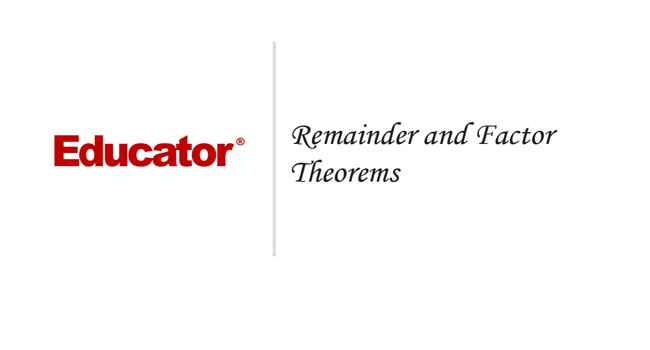Connecting...

This is a quick preview of the lesson. For full access, please Log In or Sign up.
For more information, please see full course syllabus of Algebra 2
For more information, please see full course syllabus of Algebra 2
Algebra 2 Remainder and Factor Theorems
Lecture Description
The remainder and factor theorems are very important when dealing with dividing polynomials. The remainder theorem tells us about the remainder if a polynomial is divided by (x-a). Synthetic division can be used to find the value of a polynomial function, and this procedure is called synthetic substitution. The factor theorem is a result of the remainder theorem and it tells us when x-a is a factor of the polynomial f(x). This is very useful in problems where you need to confirm the factor, and to factor polynomials. When you have a polynomial of degree 3, you need to use guess and check to find one of the solutions.
Bookmark & Share
Embed
Share this knowledge with your friends!
Copy & Paste this embed code into your website’s HTML
Please ensure that your website editor is in text mode when you paste the code.(In Wordpress, the mode button is on the top right corner.)
×
Since this lesson is not free, only the preview will appear on your website.
- - Allow users to view the embedded video in full-size.
Next Lecture
Previous Lecture









































 Carleen Eaton
Carleen Eaton Grant Fraser
Grant Fraser
 Answer Engine
Answer Engine



1 answer
Sat Nov 7, 2015 5:50 PM
Post by Fadumo Kediye on October 13, 2015
P(x) = 2x^3 + ax^2 +bx + 6 is divided by x + 2, the remainder is -12. If x - 1 is a factor of the polynomial, find the values of a and b.
2 answers
Last reply by: Fadumo Kediye
Tue Oct 13, 2015 11:42 PM
Post by enya zh on September 29, 2012
At about 25:49, you didn't list EVERY POSSIBLE factor. Isn't all the factors 1,(x-2), (x+3), (x-4), (x^2-x-12), (x^2+x-6),(x^2-6x+8),&(x^3-3x^2-10x+24)? 1 and itself would always be factors and I got three additional factors with the degree of two by multiplying the binomial factors.
1 answer
Last reply by: Huseyin Kayahan
Fri Oct 14, 2011 5:45 AM
Post by Huseyin Kayahan on October 14, 2011
In the f(a) example, why the f(2) is equal to remainder?
what is the f(3) with the division method?